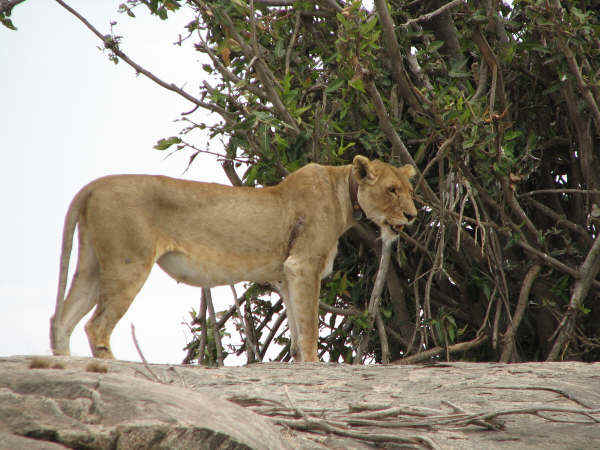ORDER:
Carnivora
FAMILY: Felidae
GENUS: Panthera
SPECIES: leo
- I.
DESCRIPTION:
-
Typically
a mature male stands 4 feet at the shoulder and is 8 .5 feet long,
plus tail. He'll average 450 pounds. Females are considerable
smaller, weighing less than 300 pounds. Adult lions usually have a
plain unspotted coat, light brown to dark ochre in color. Cubs are
marked with spots which sometimes persist on the legs and belly
until they are fully grown. Male lions have a brown mane, which
tends to grow darker and fuller as the animal ages. The tail has a
black tuft at the end. "White" lions occasionally occur in
the Transvaal region of southern Africa, but these are not true
albinos.
-
- II.
GEOGRAPHICAL RANGE AND HABITAT:
-
Years
ago, lions were common throughout southern Europe, southern Asia,
eastern and central India and over the whole of the African
continent. Today, with the exception of some 300 highly protected
animals in the Gir National Park of India, the only naturally-occurring
lions are found in Africa. But even in Africa lions have been wiped
out in the north; the last Numidian male was shot as a trophy in the
1930s. Lions do not live in heavy forests and jungles and they do
not inhabit desert areas due to a scarcity of game.
-
- III. DIET:
-
Lions
feed on a variety of large and medium-size prey. They prefer wildebeest
(or gnu) to all others when the annual migration brings the vast
herds through the pride's range. Otherwise they eat buffalo, zebra,
antelope, giraffe, and warthogs. They also steal kills and carrion
from other predators.
-
- IV. LIFE
CYCLE/SOCIAL STRUCTURE:
-
Lions
are the only cats that live in large family groups. Each pride
differs in size and formation, but a typical pride consists of two
males and seven females and a variable number of cubs. Females are
usually sisters and/or cousins that have grown up together. When the
pride hunts as a group they employ an ambush that forces large prey
into the waiting paws of the males. Females have the speed but lack
the body weight to knock down large "family size" prey
such as the wildebeest. Despite their tremendous power and adaptive
efficiency, lions are more likely to fail than succeed in their
attempts to kill.
Subadult
males are driven out at 2-1/2 to 3 years of age and may go in a
group with other males. Females mature in about two years, males a
few years later. All big cats are induced ovulators, i.e. release of
the ovum is brought about by the act of mating. The period of
gestation for the lioness is between 105 and 118 days and usually
three or four cubs will be born. Only one in five will survive the
first year. When game is scarce the dominance hierarchy based on
size and age quickly becomes apparent. The youngest die first.
Life
span in the wild is 15-18 years, in captivity 25-30 years.
-
- V. SPECIAL
ADAPTATIONS:
-
Backward-curved
horny papillae cover the upper surface of the tongue; these are
useful both in holding onto meat and removing parasites during
grooming. The roar of a lion can be heard up to five miles away and
can be most intimidating up close. Territorial roaring is usually
heard an hour after sunset. When separated they roar to let each
other know where they are; females often call their cubs by roaring.
The mature male's mane not only makes him appear larger but protects
his throat from his mortal enemies-other marauding lions and the
hyenas after his cubs or kill.
-
- VI.
INTERPRETIVE INFORMATION:
-
A
lion is a digitigrade, or toe walker; that is his heel doesn't touch
the ground. His loud roar is made possible by the cartilage in his
throat having ossified into bone (referred to as the Hyoid
structure). This is true of all the big cat or "roaring"
species. The smaller cats with the softer throat structure can only
meow.
-
- VII.
STATUS IN WILD:
-
As
a result of widespread persecution, cats in the wild have become one
of the most threatened major groups of land animals. Nevertheless,
the African lion numbered perhaps 200,000 individuals in 1991. They
are generally protected even through some 150 humans have been
mauled in the Gir National Park alone. Conversely in the Skeleton
Coast Park in West Africa's Namibia the lions are all gone. Some
were killed outside park boundaries by livestock herdsmen; others
were forced to leave by drought.
|

